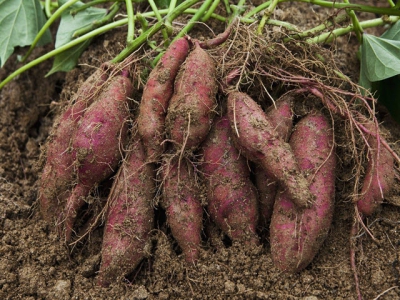Irrigation & pest control in sweet potatoes

For sweet potato runners to root, the soil around the plants must be moist. Usually, the irrigation applied just after planting will be enough, but this depends on soil type and weather conditions.
Irrigating lightly a few times will not only ensure sufficient moisture for rooting, but encourage any weeds not controlled by pre-emergence herbicide to germinate. You can then control them as described in last week’s article. Initially, little water is required. The leaf area is small, so not much moisture is extracted from the soil. This changes as the leaf area increases towards summer.
Keep a close watch on the soil moisture level and check for wilting during the heat of the day. The correct moisture level will provide better growing conditions for a higher yield. It will also reduce the chance of cracking, which occurs when very wet conditions follow dry weather as the roots develop.
Although the cracks heal, they spoil the appearance of the root and the crop is likely to be downgraded. Because sweet potato is a hardy crop that grows like a weed, there’s a danger of neglecting it somewhat – and suffering the consequences at harvesting. An insect that can be a problem from time to time is the sweet potato hawk moth. This large moth lays eggs singly on sweet potato leaves at night so is never seen on the land. The larvae feed on the underside of the leaves.
They look similar to mopane worms and are approximately the same size – 4cm to 5cm. As the pest is so sporadic and lays many eggs in a short period when the weather is favourable, it can take one by surprise. When growing sweet potatoes on a large scale, I would be alerted to the problem by the presence of white storks on the land. As soon as we found the caterpillars, we would tell our workers, who would harvest and dry them as they did mopane worms.
This is not the ideal way of solving the problem, however, because by the time the caterpillars reach harvestable size they can have done considerable damage if their numbers are high. Unfortunately, the storks are so scarce these days that they cannot be relied on to bring a moth problem to your attention or control the pest. Several insecticides to control the larvae are available. But it’s preferable to use biological products that do not harm the parasitoids which control this and other sweet potato pests.
Attacking other crops
Ironically, the sweet potato hawk moth can be your ally when it comes to other crops. You may think that because there are no sweet potato plantings nearby the moth will not be present, but this is not the case. Convolvulus arvensis, a fairly common weed, is also a host. Back when the choice of herbicides was limited, I planted a crop of maize on what was supposed to be virgin soil.
The only weed to emerge was C. arvensis – and there was plenty of it. The seeds clearly have remarkable longevity and the species is very resistant to most herbicides. While pondering what to do, as I could not afford hand-weeding at the time, I noticed thousands of sweet potato hawk moth caterpillars feeding on the weeds. They cleaned up every last vestige of C. arvensis and saved me a great deal of money and effort.
Cutworm – the old enemy
Another pest of sweet potatoes – and indeed all crops – is cutworm. In this case it’s better to add a pyrethroid to the weedkiller applied at or just after planting. This takes care of the potential hazard in the most economical way.
Related news
 The future of sweet potatoes
The future of sweet potatoes Sweet potato consumption has not grown in the way it should have. When travelling in the Mpumulanga Lowveld 35 years ago,
 Growing sweet potatoes
Growing sweet potatoes Unless you obtain clean planting material from time to time, there is a risk of virus lowering yield and quality in your sweet potatoes.
 Sweet potatoes after planting
Sweet potatoes after planting Sweet potatoes are highly adaptable when it comes to soil type. I have grown this crop commercially in soils ranging from sandy to a very heavy clay.